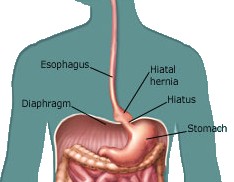

Hiatal Hernia & Other Valves
"Jack Ritchason taught me that he has never seen a person who has a degenerative disease who does not have a hiatal hernia and a weak digestive system. My own experience confirms this. Hence, pulling down their hiatal hernia is a very important step in helping these people recover. If you don’t know how to do this, get someone to teach you." (Steven Horne)
What is a Hiatal Hernia?
 Hernias occur when one part of the body protrudes through a gap or opening into another part. And although a hernia can theoretically develop almost anywhere, most are in the abdominal area. This includes hiatal hernias — also known as diaphragmatic hernias — which form at the opening in your diaphragm where your food pipe joins your stomach.
Hernias occur when one part of the body protrudes through a gap or opening into another part. And although a hernia can theoretically develop almost anywhere, most are in the abdominal area. This includes hiatal hernias — also known as diaphragmatic hernias — which form at the opening in your diaphragm where your food pipe joins your stomach.
Most small hiatal hernias don't cause any problems, and you may never know you have a hiatal hernia unless your doctor discovers it when checking for another condition. But a large hiatal hernia can allow food and acid to back up into your esophagus, leading to heartburn and chest pain. Self-care measures or medications can usually alleviate these symptoms, although very large hiatal hernias sometimes need surgical repair.
Signs and symptomsMost small hiatal hernias cause no problems. But larger hernias may cause heartburn, belching or chest pain when stomach acids back up into your food pipe (esophagus). These signs and symptoms tend to become worse when you lean forward, strain, lift heavy objects or lie down, and they can also worsen during pregnancy.
In rare cases, the part of your stomach that protrudes into your chest cavity may become twisted (strangulated) or have its blood supply cut off, leading to:
- Severe chest pain
- Difficulty swallowing (dysphagia)
- Obstruction of your esophagus
Recommendations
In 50% of population over 40. Ulcers often accompany hiatal hernia. Due to leakage of stomach acid back into lower esophagus - sometimes into throat.
Herbals:
Spleen activator - helps repair diaphragm that is weak
MSM - burning and heartburn
Aloe Vera -1oz 15-30 min. before each meal
Catnip - 4 capsules after each meal to relax hernia
Papayamint - 2 before meals
Stomach comfort - a herbal turns to absorb excess H.C.L. use only between meals and at bedtime
Diet:
Dont' eat before bedtime.
Avoid caffeine, tea and dairy
Don't eat fruit with meals;
Breathe deeply and slowly
Hold the oxygen in your lower abdomen
Three Valves To Take Care Of

For all valves
use a couple of dops of NSP Peppermint Oil
and Jojoba Oil for these massages.
Valve #1. (hiatal hernia)
As you exhale, massage inward and downward, the valve #1.
It is located just below your solar plexus, pushing your stomach down.
Valve #2. (ileo cecal valve)
Massage inward, up from your right hipbone towards your navel.
Valve #3. (pubic valve)
Massage straight inward in rotation.
(Approx. 2½ inches above pubic bone)
The Ileo-Cecal valve [2] is a small muscle located between the small and large intestine. Found only on the right side of the body, this one way check valve allows our food to pass into the large intestine for further processing.
The proper function of this valve is to open and close upon demand. When this muscle sticks in the open position it causes a backwash from the large intestine into the small intestine, allowing fecal matter to be used in the making of blood. This has great consequences as the small intestine is where the process of creating the blood/fuel to feed the body begins.
When this muscle is stuck closed, the process of eliminating waste will be hindered. Both of these conditions are very toxic and can cause a problem anywhere in the body.
This drawing also indicates the duration of each digestive process. Food enters the mouth and is passed through the pharynx and esophagus into the stomach, where it is partly digested. That is, if one has enough "digestive enzymes" in the stomach.
(Some of NSPs Enzymes combinations: PDA, Food Enzymes, Proactazyme, ProteasePlus.)
The small intestine completes the digestion and absorbs digested foods. The large intestine absorbs water.
Indigestible residue collects in the rectum for later disposal.
|